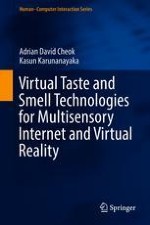2018 | OriginalPaper | Chapter
3. Science of Olfaction
Authors : Adrian David Cheok, Kasun Karunanayaka
Published in: Virtual Taste and Smell Technologies for Multisensory Internet and Virtual Reality
Publisher: Springer International Publishing
Activate our intelligent search to find suitable subject content or patents.
Select sections of text to find matching patents with Artificial Intelligence. powered by
Select sections of text to find additional relevant content using AI-assisted search. powered by
